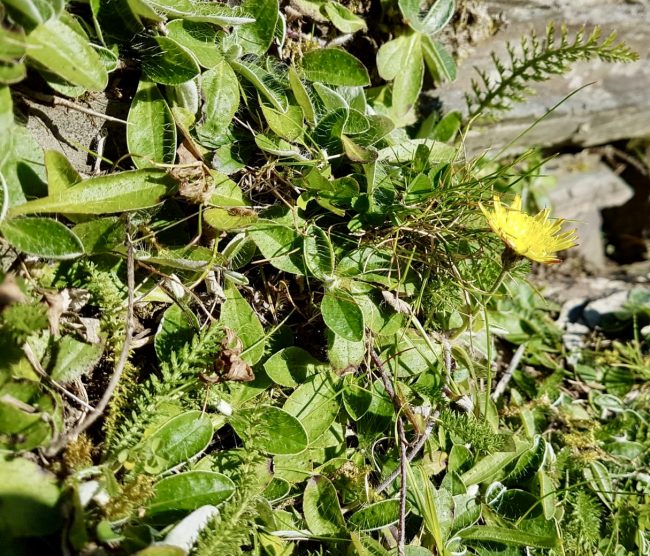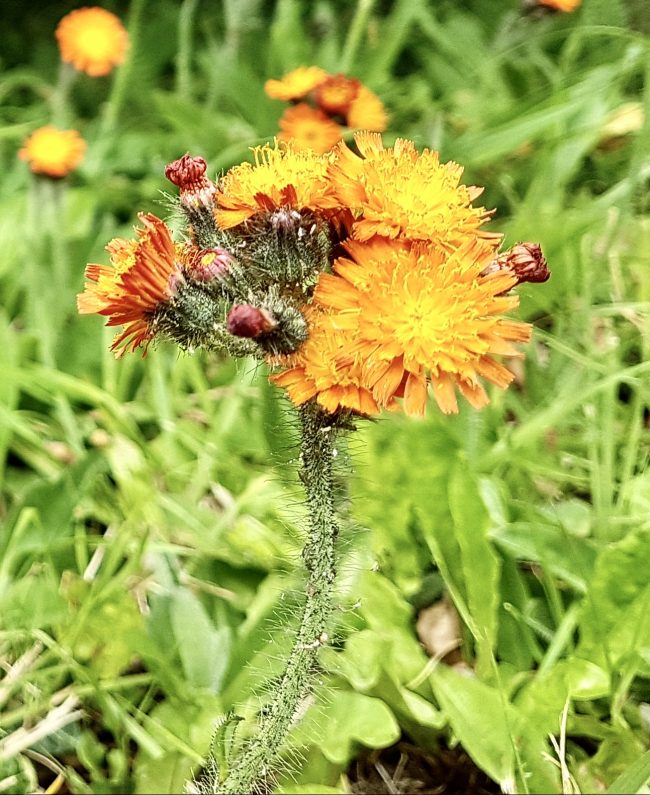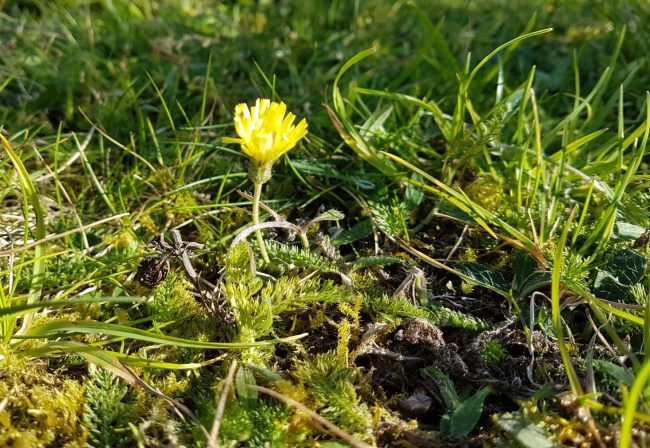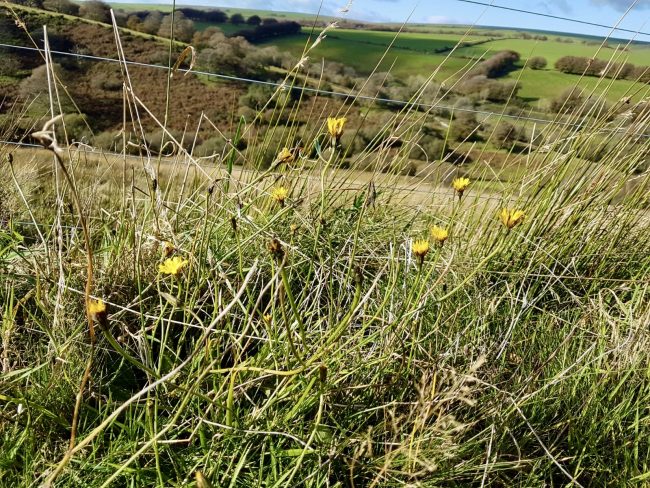Deadly pollen

Hawkweeds are wild flowers of dry, grassy places, but also to be found on walls, rocky places, and pavements. Some are regarded as invasive species in some parts of the world. The botanical genus Hieracium is known by the common name : the hawkweeds. It is thought that the common name derives from the writings of Pliny the elder, who believed that hawks sprinkled sap from the plants into their yellow eyes to dispel dimness.
The genus is a member of the sunflower / daisy family: the Asteraceae. They are closely related to dandelions (Taraxacum) and sow thistles (Sonchus). There are thousands of different Hawkweeds; but botanists classify British hawkweeds into about 340 “species”, many of which are quite rare. Identifying them is difficult and best attempted when there is fresh growth and new leaves. The classification of the hawkweeds is difficult, partly because the plants use apomictic reproduction. This means that seeds that are formed without the usual processes of pollination and fertilisation.
Though the pollen of hawkweed may serve no direct function in the reproductive process of the hawkweed, when the pollen (of certain species) is transferred to other plants by bees or other pollinators, it kills their embryos. The hawkweed pollen stops their competitors from producing seeds. By killing the offspring of other plant species, it reduces the competition for space and resources for the seeds of the hawkweed. When one species inhibits the growth or development of another by chemical means, this is known as allelopathy.

Hawkweeds are perennials. Below ground, they may have a short and stout rhizome. The roughly elliptical leaves can be up to 5 inches long and have teeth towards the base, they tend to form a rosette near the ground. Hawkweeds are often noted for their hairiness (see image of the stem of the orange hawkweed).

Orange Hawkweed (Pilosella aurantiaca) - note the very hairy stem
Most produce pale yellow flowers during the summer months. The closely packed flower-heads are made up of many small flowers (florets). The number of florets varies between 40 and 80. The flower heads start off together but gradually separate from each other on the leafless stems. The fruits are dark brown, one seeded fruits - called achenes. When cut, hawkweeds may exude a white latex.

Hawkweed
Some hawkweeds can be quite dominant plants, growing to a height of three feet (e.g. Hieracium vulgatum), but they are frequently much smaller. The orange hawkweed is unusual because of its bright orange colour and is quite a pretty flower but is considered invasive in areas like British Colombia. In Victoria and New South Wales, Australia, hawkweed species are declared to be "State Prohibited Weeds" and are controlled under The Bio-Security Act 2015.

Photos - thanks to my friend : Art Symons.
Comments are closed for this post.
Discussion
Do you have a reference for the paper that discusses the pollen’s effect on other plants? The Guardian link is broken. It would be good to know what species are being referred to as ‘hawkweed’ covers several genera and numerous species. This lack of detailed information leads to comments like the one above enquiring whether fox & cubs should be removed before it sterilises other plants.
I’ve just found an orange hawk weed plant in my garden.
Should I be concerned ?
Or is it good for bees as my garden is more for wildlife than manicured.
apart from John Tindle’s comment below, there is also information on Hawkweeds here https://assets.publishing.service.gov.uk/government/uploads/system/uploads/attachment_data/file/801153/code-of-practice-on-how-to-prevent-the-spread-of-ragwort.pdf
I have hawkweed which has appeared across much of my no mow former lawn.
I also have many other flower species and want to maintain the variation so would I be best to pull up the hawkweed before it flowers so that it doesn’t sterilise other plants?
The attractive orange hawkweed is spreading fast in the UK being transferred by seeds spreading once the flowers have turned to seed. It is a real “thug” spreading rapidly in the ground and lawns once established.
Even its pollen is poisonous to other plants causing their young offspring to die. It produces abundant seeds which infect nearby gardens in urban areas. The orange hawkweed is unusual because of its bright orange colour and is quite a pretty flower but is considered invasive in areas like British Colombia, and in Victoria and New South Wales, Australia.
Hawkweed species, indeed all species of the genus Hieracium are classed as invasive species throughout New Zealand. They are banned from sale, propagation and distribution under the National Pest Plant Accord.
Hieracium is a pasture weed that reduces available feed for livestock and displaces the indigenous plants. In the United States, many species of Hieracium have been introduced and all species present are considered noxious weeds in one or more states.

The blog tries to offer a short and readable summary of various topics, headlining main or interesting points. It does not pretend to offer detailed reviews of particular studies.
The Guardian link on Hawkweed seems to still be available : https://www.theguardian.com/environment/2020/sep/22/country-diary-the-killer-role-of-pollen-in-the-hawkweeds-life-cycle
And there is further information here : https://www.cambridge.org/core/journals/weed-technology/article/abs/role-of-pollen-allelopathy-in-weed-ecology/4110EA8F8C1F7DB65F9B1F85BD8AC380 . This paper refers to orange hawkweed, parthenium, yellow hawkweed, and yellow-devil hawkweed as pollen-allelopathic species. Murphy, Stephen D. 2001. The role of pollen allelopathy in weed ecology. Weed Technology. 15(4): 867-872. [80316]
Also see : https://www.jstor.org/stable/3988569
and : https://research.qubs.ca/projects/in-vitro-allelopathic-effects-of-pollen-from-three-hieracium-species-asteraceae-and-pollen-transfer-to-sympatric-fabaceae
Blogs
24 June, 2023